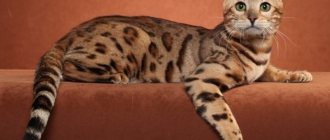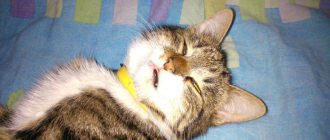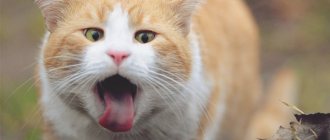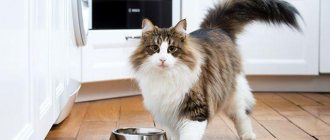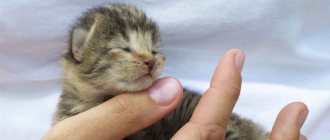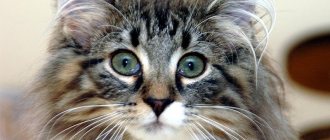Origin story
The Scythian Tai Don is an almost exact copy of the Siamese cat, only smaller and not as grumpy in character.
This is a very young breed: the first kitten was born in the late 80s, in Rostov-on-Don. Breeder Elena Krasnichenko brought together a short-tailed cat and a Thai cat found on the street. The kitten that was born was unusually small in stature, and its tail was indecently short. The reason for this is a banal mutation, but the breeder thought this pop-eyed baby was funny. Kutsy (as he was called), despite his diminutive size, was cheerful and cheerful, and early began to be interested in the opposite sex. Some of his kittens were just as small, and the breeder decided that this was a chance to try to establish a new breed.
It didn't take much time. Already in 1994, the breed received the name Skif Tai Toy Don, standards and registration in the WCF system.
This unusual name combines the name of the territory (Skif) and the river (Don) on which the little one Kutsy grew up, and also indicates the presence of foreign blood (Thai cats) and the similarity with a toy (that).
At the World Cat Show, Skif Tai Don made a splash. A nice couple - Pashka and Mickey - went to the distant United States of America, where hard work began on breeding the breed. In 2009, the breed was included in the International Felinological System TICA under the name “Toy Bob”, but in Russia... In Russia by this time things were very sad - the breed almost became extinct. The cats were rescued by enthusiasts from Yekaterinburg. The minimum number of livestock has been restored.
Owner reviews
Owner reviews are overwhelmingly positive. Their impeccable health and extraordinary character leaves no one indifferent who has ever met them. The owners are especially pleased with the silence of this breed. They make any sounds on extremely rare occasions. Even cats behave quietly during the period of sexual desire.
This is an easy-going, soft-tempered pet, with the soulful gaze of large sky-blue eyes . Most children like them and are even used in rehabilitation centers after undergoing special training. Working with children is their calling. These cats do not require privacy, they are not afraid of loud sounds or the screams of children. They will never scratch a baby who is squealing with joy and hugging them.
They are not afraid of the sounds of bursting balloons; these cats themselves fawn to be stroked. These cats help the socialization and adaptation of “special” children. When interacting with toy beans, children loosen up faster and respond to therapy, they make contact more easily, and smiles are more often visible on their faces.
We would like to express our gratitude to the Skif-Toy-Bob cattery “KUTS” for their assistance in preparing this publication.
Return to content
Standards
| Standard | Description |
| Head | Small, wedge-shaped. The chin is small and round, the cheekbones are narrow and prominent. The nose is also small, but wide, proportional to the size of the muzzle. The ears are tiny and not set very wide. Their ends are pointed. The inside of the auricle is pubescent. |
| Eyes | Almond-shaped or round in shape, set close to the bridge of the nose and slightly oblique. The iris can be blue or green in all shades. |
| Torso | Small, elegant, compact. The muscles are well developed, the chest is wide, the back is rounded. The limbs are thin, dry, and do not look beautiful. The paw pads are elastic, clearly defined, strong. The front legs are shorter than the hind legs, which is why these animals have a leisurely gait, as they say, “waddle.” |
| Tail | Short (no more than 5-7 cm), consists of a couple of vertebrae. Shape: spiral, tassel, pompom, short bob. There are creases. |
| Wool | Hard and dense, with short undercoat. |
Cats of this breed are not allowed to be “mated” with other members of the cat family!
Skif will not be allowed to participate in competitions and exhibitions if he has:
- Underdeveloped chin or bite;
- Too elongated muzzle;
- The ears are excessively large and pointed;
- The head is too narrow;
- Long wool;
- The body is large or narrow and elongated.
Appearance
Toy beans are small cats of strong build with large, round, expressive eyes on a rounded muzzle. Size is smaller than average. The preferred weight is up to 2 kg, cats are slightly larger, but in general sexual dimorphism is not clearly expressed. Before the appearance of the toy bean, the Singapore cat was considered the smallest cat.
The head has a trapezoid shape with rounded contours. In profile, the transition from forehead to nose is well defined. The bridge of the nose is slightly convex and may be straight. The muzzle is short and round. The eyes are large, round and wide open, very expressive. The color is deep blue. The ears are set high, medium in size, slightly tilted forward. The distance between the ears should not exceed the width of one ear at the base. The neck is short and strong. The body is square in shape, compact and dense with moderately developed muscles. The back is almost straight. The legs are not long, strong, the hind legs are slightly higher than the front ones. The paws are oval in shape, the toes on the hind legs are elongated.
The tail is small, mobile, must have at least three vertebrae, and the visible length is no more than 1/3 of the length of the body. The tail must have creases or bends in any combination.
The coat is short, semi-adjacent with moderate undercoat. It feels elastic, soft and dense to the touch. The outer hair is slightly longer. Color – seal point only (the cream color on the body gradually darkens to light brown, the markings are dark brown.) The color should be rich and even.
Character and behavior
Cats of the Scythian Tai Don breed are real kibalchishi boys: fearless and very loyal. Despite their miniature size, Scythians are not afraid of anything around them: no loud sounds, no big dogs, no cars, no fire. Thanks to their tenacious claws, Scythians deftly climb onto shelves and cabinets, climb up the curtains right up to the ceiling and jump onto the sofa below, poke their curious nose into every more or less accessible place in the house, threaten all the birds flying past the window - in short, do not let their owner get bored. Therefore, immediately ask yourself: am I ready to watch this little prankster from morning to night?
With the appearance of a Scythian in the house, you will have to seriously reconsider the home “security system”: put special bars on the windows so that the cat does not fall out, hide all the wires, put away dangerous and small objects (tangles, threads, buttons, needles, buttons, medicines, household chemicals).
Moreover, the activity of Scythians does not decrease at all with age: running circles around the apartment, frantic jumps and games do not stop at 3 years old and at 5 years old. Your task: to arrange a cozy corner for your baby in which he can splash out his energy. The cat complex will help you with this - a multi-level structure with many tunnels, houses, ropes, beds and steps. The more there are, the better.
The complex will not only protect your furniture from scratches, but will also prevent dangerous diseases such as obesity, muscle atrophy, metabolic disorders, and the like. You can buy it, but you can also make it yourself - your pet will have just as much fun with a homemade one.
The complex must be safe! Therefore, give preference to durable frames, rigid upholstery fabrics, foam padding (sintepon) and good quality dyes.
Train yourself to put small things - such as flash drives, keys and headphones - in a lockable drawer or box with a lid. Scythians love to play with such things, they constantly drag them from corner to corner, and when they are finished having fun, they hide them in secluded places.
The friendliness of the Scythians is overflowing. They adore people, not only members of their family, but also everyone who drops in for a glimpse, sincerely consider them their best friends and immediately try to involve them in their games.
They are not afraid of children, even small ones. They patiently endure all their squeezing and are ready to play with them for hours. They do not release their claws and do not bite, even if they are hurt.
Name the cat who always wanted to live together
BasilioLeopold
Scythians are compared to dogs: maybe because of their devotion to people, or maybe for another reason. Breeders claim that the meowing of an excited Scythian is very reminiscent of a dog's bark. But, be that as it may, these cats are also wonderfully trainable: it will not be difficult for you to teach cats a few simple commands: “lie down”, “give me a paw”, “sit”, “come to me”. Naturally, not by forcing, but in a playful way.
Wanting to get a share of attention, the skiff turns over on its back and exposes its unprotected belly to the person. At the same time, he purrs and moves his paws invitingly.
Scythians treat other animals in the house calmly, without showing aggression, but also in no hurry to make friends. The hunting instinct of these babies is well developed, so do not let rodents and small birds roam freely.
And it is better to keep Scythian dogs away from large parrots and dogs, otherwise the latter will be given a beating, and he will not really be able to give change. Especially watch out if the second animal in the house is jealous.
They don’t meow in vain, even during the “rutting” period. Their main sounds are muffled snorting or growling. They do not mark the territory and do not smell (even uncastrated males).
They love to sit on the warm lap of their owner, “hugging” the hand with all their limbs. Ready to have fun like this for hours on end. There is never a fight for supremacy in the house.
They walk with pleasure. They walk patiently on a leash and do not try to run away.
Unfortunately, finding a kitten of the Skif Tay Don breed in Russia is a difficult matter. Cats of this breed are bred only in two or three cities, and since breeding work is both risk and expense (and there are usually few babies born in a litter), the cost of a kitten is very high. A male without a pedigree and not for breeding will cost at least 50,000 rubles, a female - a couple of tens of thousands more. Skiffs for exhibitions are valued at over 100,000 rubles, and you can only buy them at the nursery.
Mister Cat Recommends: Temperament Features
Miniature Scythians are very funny in appearance and have a courageous and cheerful character.
They are constantly active - both in early and adulthood. These pets simply need a well-equipped corner; it is better to purchase a large complex with poles, ropes and hanging bridges. Otherwise, kids will climb curtains and walls.
It is advisable to have a lot of toys in the house, including rubber ones. That bean can carry them in his teeth all day.
Frankly fearless. Little Skif is not afraid of open fire, loud music, even fireworks.
Smart and smart. Despite his love of hunting for toys and insects, he understands that the parrot is a pet and does not touch it. Makes friends and plays with all animals.
She adores her owner and can sit on his lap for hours, clasping her hand with all four paws. Tai resembles a small lemur. Or he falls on his back and lies under the feet of his household until he is picked up.
The pet is silent and almost never meows. Occasionally makes sounds that are more like a growl or a hoarse bark. And in habits it resembles a dog - it easily gets used to a harness and is able to walk on a leash on the street, loves to bring small objects to its owner and, like a faithful dog, wait for him near the door. He will quickly learn commands - sit, lie down, give a paw.
Even an adult, uncastrated cat has no odor and does not mark its territory.
He plays with children with pleasure and is absolutely non-aggressive.
Care instructions
These are very clean cats, but they still need human help.
Wool
The Scythian's coat is not prone to matting, so you don't need a suitcase of combs and sprays: just buy one brush with natural bristles and brush the Scythian 1-2 times a week. During the molting period you will have to do this 2 times more often.
Bathing
Scythians do not need to be persuaded to take a bath: they love water and will happily swim in a basin and race with a rubber toy. But carry out water procedures no more than once a month - if the skiff is walking along the street, and no more than once every 6 months - if he does not leave the house. Otherwise, irritation will appear on the skin.
Human shampoos should not be used: they cause dermatitis and intestinal upset. Pet stores sell soft cleansing preparations (Bars, Celandine) that do not cause harm.
Ears
Dirt and wax from the ears are removed with a cotton pad soaked in a warm decoction of chamomile, celandine or string.
Teeth
The Scythian will have to brush his teeth regularly - every week for 3 minutes, in a circular motion from top to bottom. If tartar has already appeared, or the gums are inflamed, take the Scythian to the veterinary office for a cleaning procedure.
Accustom your animal to these procedures from childhood. Do everything softly and smoothly, without raising your voice, letting the skiff play with the toothbrush and taste the paste.
Scythians quickly become accustomed to the litter box. And, by the way, it’s not difficult to teach them to go to the toilet.
In the photo there are kittens of the Skif Tai Dong breed
Buy skif-toy-bob
The strictest control during breeding of cats of this breed dictates its price. It is also important to know that these kittens are not bred at home. Sales are carried out exclusively by specialized nurseries. Rostov, Moscow and Novomoskovsk are the main cities where these miniature cats are concentrated. Although their distribution has reached a much larger scale. They have been in France, the USA, Germany and Belgium for a long time. Toy Bob cats live in Belarus and Russia.
Advertisements on the Internet can be placed both by unscrupulous sellers who pass off immature Siamese kittens as toy bobs, and by reputable breeders. And since this breed is quite expensive and rare, special care should be taken not to buy a “fake”, rootless kitten for exorbitant money, which will soon grow to 4 kilograms. The only proof that a kitten has breed standards is documents about its origin. Any self-respecting breeder can provide them to you. And no, even the most persistent and convincing stories can compare with them.
What to pay attention to
When buying a kitten, first of all, you need to ask the breeder to provide all the necessary documents to ensure the authenticity of the breed and the absence of natural developmental defects.
After that, having chosen a kitten, carefully examine it. The baby must be healthy, vaccinated according to age, active, socialized, and look cheerful. Toy Bob kittens are playful and active. The kitten should not have any unnecessary visible discharge; the animal's eyes, nose and ears should be clean. Take the baby in your arms and touch him lightly. The body body should be strong, proportional, the paws should be straight without defects, the belly should be soft and not swollen. The tail may be “twisted” or slightly bent.
Toy bob kitten price
You should be careful when buying a suspiciously cheap kitten . Baby skif-toy-bobs cannot cost less than 70,000 Russian rubles. The cost varies from 70 to 250 thousand rubles. In rare cases, a kitten can cost up to 300 thousand. This is the price they can ask for for a kitten from an elite cattery. The final cost also takes into account the gender, degree of conformity to the breed, weight and character of the animal.
This is interesting! Despite such a high price, these miniature cats are extremely in demand. Therefore, in pursuit of a top-class baby, it is better to take care of booking in advance.
Catering
Scythians eat both natural food and industrial food with equal pleasure and are not picky. A small organism spends a lot of energy, and accordingly, it needs more food. But if you feed a cat, it will quickly gain excess weight and begin to get sick.
Natural products
When choosing natural food, remember the following:
- The main component of a cat's diet is meat (half is muscle meat, a third is offal and offal). The meat is not boiled, but given raw, having first been doused with boiling water;
- 5-10% - vegetables (zucchini, pumpkin, carrots, cucumbers, greens). The amount can be increased, but decreasing is not advisable, since cats only get fiber from plant foods;
- 2-3 times a week - eggs, both chicken and quail. Quails are given whole, from chickens - only the boiled yolk;
- Fish is given instead of meat, but no more than once a week. You shouldn’t give up fish completely – it is a source of fatty acids. Choose sea varieties: hake, salmon, trout, flounder;
- Fermented milk products can be given every day. This is low-fat cottage cheese, natural yogurt without additives or dyes, sour cream, cream, fermented baked milk;
- Porridge (oatmeal, rice, millet, buckwheat) is given daily. They are boiled in water, you can add just a little milk for flavor;
- Vitamin and mineral complexes are added after consultation with a veterinarian.
It is prohibited to give:
- Legumes - they provoke the formation of gases;
- Sweets cause diabetes (but melons and apples are allowed);
- Coffee, alcohol, tea, mineral water, juices;
- Salty;
- Fatty meat (pork, duck);
- Human canned food, dog food, human vitamins;
- Mushrooms;
- Eggplants, grapes;
- Onions, garlic, potatoes: on the one hand, they are allowed by the BARF natural feeding system (in ready-made feeds), on the other hand, they should not be added fresh to porridges or broths, as they will irritate the gastric mucosa;
- Whole cow's milk;
- Baked goods, flour, smoked.
Train your cat to eat in the same place. Give food heated to a comfortable temperature: not hot, but not cold. Wash the bowl after every meal without using detergents.
Recommended food
From ready-made feeds, it is advisable to choose holistic class feeds. They are made from high quality products and contain sufficient amounts of meat, vegetables and vitamins. The following foods have proven themselves well: Jaguar, Pronature Holistic, Riverwood.
Below are the recommended holistic foods. Links with the names of the food are clickable, on them you can, within our website, get acquainted with the descriptions of the food and read reviews from owners of cats of the Skif Tai Don breed.
| Holistic | Holistic | Holistic |
| PureLuxe | One&Only | Nutram |
Make sure your cat always has clean, fresh water in her drinking bowl. Do not feed your pet from the tap: tap water contains too much chlorine and salts. Pass the liquid through a household filter or settle it the old-fashioned way: in a jar without a lid.
Description of skiff-toy-bob
The main distinguishing feature of the skiff-Tai-bob will always be his childish appearance. Looking at the blue eyes, small body and short tail, one gets the impression that before one’s eyes is a kitten that has not yet reached the age of six months. Despite this, he has a strong, well-developed body. Its dimensions are proportional, its back is slightly arched, its chest is rounded. The Toy Bob's physique is muscular. The maximum body weight of a bob is 2 kilograms. Minimum – 800 grams. Cats weighing 1 kilogram are most valued. Females are slightly smaller than males, although the sexual dimorphism of the breed is not pronounced.
They have medium, thin paws, with round, neat pads. The hind limbs are slightly longer than the forelimbs. The tie-bob tail is a separate issue. Its length does not exceed 8 centimeters. In some cases, it generally looks like a neat pompom or tassel. The tail can be either straight or spiral-shaped.
The breed got its head shape from Thai Bobtails. It looks like a wedge tapering towards the bottom. The chin is rounded, the cheekbones are chiseled and narrow. A small nose is located in a thin line from the forehead to the bridge of the nose. The ears can be rounded or pointed at the ends; they are small relative to the body. The eyes of Toy Bob cats are almond-shaped. There are rare cases when nature paints them greenish-yellowish. They are usually the color of sky blue, blue or blue.
This is interesting! The animal's fur is hard to the touch, although visually it looks soft. It is thick and dense, of equal length throughout the body. Long-haired toy beans do not exist in nature.
The most common color is seal point, although there are other variations . But the arrangement of shades is always preserved - the muzzle, ears, tail and paws are darkened, the rest of the body is much lighter.
Breed standards
A real toy bob should not weigh more than 2 kilograms. The cat's body should be strong and physiologically developed with good pectoral muscles. The head is wedge-shaped, the eyes are almond-shaped, blue, less often honey or green. The ears are straight and high.
Toy Bean Character
Little bob tails are brave cats. Kittens of this breed have a pleasant playful disposition. They are funny and kind. They can boast of extreme curiosity, a desire to communicate, while they know how to be calm and show signs of balance. They easily get along with household members, other animals and even children. Children have especially fun with them; who wouldn’t like a kitten who will obediently bring a toy in his teeth? They can be trained.
The Toy Bob is not a useless “miniature cat”, he can be a good hunter. He may not be able to defeat a rat, but he can handle a butterfly, a small mouse or flies with a bang. At the same time, Toy Bob cats do not show signs of aggression. They are extremely socialized. Bob's cat, like a dog, will follow its owner everywhere, he does not have a developed desire to live a detached life, his regime is human-oriented.
Toy Bob coat colors
The most popular coat color of the toy bob is color point. With this arrangement of shades, the predominant part of the body is painted in a light color, and the ears, paws, tail and muzzle are painted in a darker shade. The colors are combined in a smooth transition. This acromelanic color is usually presented in beige color with dark chocolate shading.
Lifespan
Toy beans live, if properly maintained, within 18-20 years.
Diseases
Hereditary pathologies, unfortunately, did not spare the Scythians.
- Alopecia is partial or complete baldness. If the Scythian Tai Don begins to lick itself zealously, and bald patches appear on its skin, take the animal to the veterinarian.
- Stretching of the esophagus, intestinal cancer, blockage with hair - occurs due to a violation of the diet.
- Diabetes mellitus develops most often in old and fat animals. Breeders do not recommend feeding Scythians with industrial food.
- Tumors of the uterus and mammary glands (both benign and malignant). The reason is hormonal imbalance. Timely castration and sterilization will help prevent imbalance. Scythians begin to be interested in the opposite sex early, so decide in advance - do you need offspring?
- Inflammation of the upper respiratory tract, respiratory diseases - Scythians often suffer from these ailments for up to a year. Make sure that your pet does not freeze and does not sleep in a draft.
Care and maintenance
The owners do not have any difficulties in maintaining Skif. The only thing that needs to be done is to provide your pet with a place to express his active nature. A gaming complex and many toys, including interactive ones, are necessary.
Bob's coat never gets tangled and does not need brushing or bathing. Although the pet is not afraid of water and even loves it. In summer you can pour it into a large container. The cat will be happy to swim and play with toys in it.
Ears, eyes and nails require the usual care for all breeds as needed.
He enjoys using the scratching post. He gets used to the toilet easily, you just need to keep it clean.
Photo gallery
Below are photos of cats of the Skif Tai Don (Toy Bob) breed.
oirkha111
aquila069
cotomir
bersenevaevgenia
Advantages and disadvantages
The Scythian Tay Dong cat breed deserves attention, because it has many more advantages than disadvantages. Owners of miniature pets speak of them with love and tenderness and consider them the best cats in the world.
The advantages of the breed include:
- elegant appearance;
- light weight;
- flexible and friendly character;
- cleanliness;
- ease of care;
- patient attitude towards children;
- good learning ability.
After weighing the pros and cons, make a choice in favor of this kitten
The breed also has disadvantages:
- no fear of obstacles and larger animals;
- the activity of cats can be very tiring;
- few animals in the litter;
- high price of kittens;
- low prevalence.


